Search results for 'omer'
-
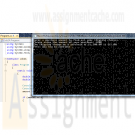
CIS 170 Week 2 iLab 2 of 7 Decisions
$15.00CIS 170 Week 2 iLab 2 of 7 Decisions
Scenario/Summary
You will code, build, execute, debug, and test two programs using decision structures. The first program will calculate the shipping charge based on a given purchase amount. The second program translates a given TV channel to its call sign.
Part A: Calculate Shipping Charge
Requirements
Your mission: Write a program that gets the amount of a purchase from the user and then calculates the shipping charge, based on the following table:
$0.00 - $250.00: $5.00
$250.01 - $500.00: $8.00
$500.01 - $1,000.00: $10.00
$1,000.01 - $5,000.00: $15.00
over $5,000.00: $20.00
Sample output from program:
Enter a purchase amount to find out your shipping charges.
Please enter the amount of your purchase: 234.65
The shipping charge on a purchase of $234.65 is $5.00.
Press any key to continue . . .
Tips
Best practice: Put yourself in the place of the program. What questions would you ask a customer in order to get the best input? How would you determine the correct shipping charges if you had to make the decisions yourself? Write out the questions you would ask yourself on paper as pseudocode and/or in Visual Studio as C# comments, and then implement them one by one, testing as you go. Remember to not write too much at one time. Always add and test functionality incrementally!
You can use the pseudocode below as a guide:
Prompt the user for the sale amount
Is sale amount greater than $5,000.00?
If so, shipping is $20.00
If not, is sale amount greater than $1,000.00?
If so, shipping is $15.00
If not, is sale amount greater than $500.00?
If so, shipping is $10.00
If not, is sale amount greater than $250.00?
If so, shipping is $8.00
If not, is sale amount greater than $0.00
shipping is $5.00
If not
shipping is $0.00
If shipping is $0.00
Display "Error incorrect input"
If not
Display sale amount and shipping charge
Learn More
Part B: TV Channel to Call Sign
Requirements
Your mission: Write a program that translates a TV channel (1 through 10) in your area to its respective call sign. For example, in the New York metropolitan area, channel 2 translates to WCBS. If a channel is unused in your area, tell the user that this is the case.
Sample output from program:
Translate TV Channel Number to Call Sign
Enter channel number: 1
Channel 1 is undesignated in your area
Enter channel number: 2
Call sign for channel 2 is WCBS
Enter channel number: 6
Call sign for channel 6 is WRNNDT
Tips
Best practice: Put yourself in the place of the program. What steps would you personally need to perform in order to process a channel translation yourself? Write out those steps on paper as pseudocode and/or in Visual Studio as C# comments, and then implement them one by one, testing as you go. Remember to not write too much at one time. Always add and test functionality incrementally!
Pseudocode: Although there are several valid ways to write the program, the following is an outline of one way to design the overall logic.
Declare variables for channel and call sign
Get channel number from user
Use appropriate decision structure to translate number to call sign
If number is valid in area
Print out translation
If not
Tell user this is the case -
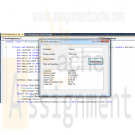
BMIS 208 Programming Assignment 2 Automobile Repair Shop
$15.00BMIS 208 Programming Assignment 2 Automobile Repair Shop
Create a Visual Basic program that creates a bill for an automobile repair shop. The shop bills customers at the rate of $35 per hour for labor. Parts and supplies are subject to a 5% sales tax. The customer’s name, the number of hours of labor, and the cost of parts and supplies should be entered into the program via textboxes. When the Display Bill button is clicked, the customer’s name and the 3 costs should be displayed in a list box as shown below.
1. Name your application Assignment_2.
2. Name the form frmAssignment_2. The title should be as depicted below.
3. Name the labels lblCustomer, lblPhone, lblHours, and lblParts.
4. Name the textboxes txtCustomer, txtHours, and txtParts.
5. Name the listbox lstBill.
6. The Customer phone textbox should be a MaskedTextBox and should allow inputs only in the form of ___-____ (3 characters, followed by a dash, followed by 4 characters). Name this MaskedTextBox mtbPhone. Show the underlines and dash in the mask.
7. If the user leaves the Customer, Hours, or Parts textboxes blank, produce an error message (using a MessageBox) that informs the user to enter the appropriate information and do not display the information in the listbox.
8. Create variables to hold the customer, phone, hours, and parts information. Name the variables customer, phone, hours, and parts. Their data types should be string, string, double, and double, respectively.
9. When the user clicks the Display Bill button, prompt the user to enter in the date of the services. Store this information in a variable called service_date. Display this date and the date the invoice is due (30 days from the date entered) in the listbox as shown below. [Hint: use the AddDays function]. Store the due date in a variable called due_date.
10. Convert the customer name variable to upper case before displaying it in the listbox.
11. Whenever the user clicks the Display Bill button, the listbox should be cleared before displaying the new results.
12. To calculate the amounts, create three variables (labor_cost, parts_cost, and total_cost), and display these amounts in the listbox as shown below.
13. Be sure to use currency format where appropriate.
14. Be sure that the columns line up appropriately. [Hint: you can use the built-in Visual Basic constant “vbTab” to create neat columns in your listbox.]This assignment is due by 11:59 p.m. (ET) on Monday of Module/Week 2.
Learn More -
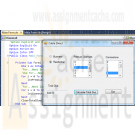
Clearly Visual Basic 2010 Chapter 7 Cable Direct Application
$15.00Clearly Visual Basic 2010 Chapter 7 Cable Direct Application
Create a Visual Basic Windows application. Use the following names for the solution, project, and form file, respectively: Cable Direct Solution, Cable Direct Project, and Main Form.vb. Save the application in the VB2010\Chap07 folder. Create the interface shown in Figure 7-39. The list boxes are named lstPremium and lstConnections. Display numbers from 0 through 20 in the lstPremium control. Display numbers from 0 through 100 in the lstConnections control. The Calculate Total Due button’s Click event procedure should calculate and display a customer’s cable bill. The cable rates are shown in Figure 7-40. Business customers must have at least one connection. Use two functions: one to calculate and return the total due for business customers, and the other to calculate and return the total due for residential customers. The form’s FormClosing event procedure should verify that the user wants to close the application. Code the application. Save the solution and then start and test the application. Close the Code Editor window and then close the solution.
Learn More -

BMIS 208 Programming Assignment 9 Microland Computer Warehouse
$20.00BMIS 208 Programming Assignment 9 Microland Computer Warehouse
The database Microland.accdb is maintained by the Microland Computer Warehouse, a mail-order computer-supply company. The tables below show data in the three tables in the database. The table Customers identifies each customer by an ID number and gives, in addition to the name and address, the total amount of purchases during the current year prior to today. The table Inventory identifies each product in stock by an ID number and gives, in addition to its description and price (per unit), the quantity in stock at the beginning of the day. The table Orders gives the orders received today. Assume that it is now the end of the day. Write a Visual Basic program that uses the three tables to do the following two tasks:
1. Display in a listbox the items that are out of stock and those that must be reordered to satisfy today’s orders.
2. Display in a listbox bills for all customers who ordered during the day. Each bill should show the customer’s name, address, items ordered (with costs), and total cost of the order.Design your form based on the diagram below.
The database that contains the tables for this assignment is contained within your Instructions folder and should be placed in your project’s bin\debug folder.
Below are the data that are contained in the tables in the database.
(Note: you do not have to reproduce these tables in your Visual Basic program. You should only create the screens shown above.)This assignment is due by 11:59 p.m. (ET) on Monday of Module/Week 6.
Adapted from Schneider, D. I. (2010). Introduction to Programming Using Visual Basic 2010 (8th ed.).Hints – the hints below are for the “Out of Stock” button function and will hopefully give you some clues as to how you can accomplish the other button’s work.
Learn More
1. Create a query1 from the order table to get the itemIDs ordered. You will want to order your query by itemID and use Distinct to eliminate duplicate itemIDs.
2. Use a for-each loop to go through query1 once per itemID. For each loop you want to do the following:
a. Create a query2 using the order table Where the itemID in the order table equals the itemID from query1. The purpose of this query is to get the quantities ordered for each itemID.
b. Use a for-each loop and a variable (let’s call it intTotalOrdered) to iterate through query2 and sum up the quantities ordered for each itemID.
c. Create a query3 using the inventory table and select those records Where the intTotalOrdered is equal to or greater than the quantity on hand – these are the records that will need to be reordered. Use a Let statement with quantity on hand and intTotalOrdered to determine the reorder quantity. Select the itemID, reorder quantity, and item description.
d. Print out itemID, reorder quantity, and item description to your list box. Use Math.Abs() on your reorder quantity to convert negative numbers to positive ones. -

Pizza Parlour Visual Basic Program
$20.00Pizza Parlour Visual Basic Program
I need to create an order form for ordering pizzas. the first screen should be splash screen that displays the name of the Pizza Parlour, a picture and my name and date I created the project.
It should then go to a main form that has the same picture and a menu at the top. The menu should show Order Pizza as the first menu item, Display the Specials as the second menu item and Exit as the third menu item across the top. When the user clicks the first option, a form will be displayed for them to order the pizza they want, for the second one, a form should be displayed to display the specials for the day. When they click on Exit, the program ends with a nice little message telling them, “Goodbye”.
When the user selects the menu option to Order Pizza, the main form should close and the new form should be displayed. On this form I need the following components.
- A textbox to allow them to enter the number of pizzas they want
- Three radio buttons to allow the user to select the size of the pizza where the first one is small for 6.00, the second one is medium for 8.00 and the third one is large for 10.00.
- Three radio buttons for the type of crust they want. , ex. Thin, Thick and
- Display a message that the first topping comes with the price of size of the pizza but every topping after that is 1.00 extra.
- Display a minimum of 8 check boxes for different toppings.
- I need a button that displays a message like, Make my order!
- When the button is pressed, you will add the choices starting with the price, then the size and then the crust type and all of the toppings they chose into an array.
- You are to then close this form and open another form to display the selections.In this form (called from step 3 to display the selections, I need to put the same menu at the top as is on the first form in step 2..
- I need a combobox of email addresses on the screen where the person will select their email address.
- Also, a button under this stating, Show Order.
- I need to create a data connection to the customer table in the PizzaDelivery Access database. I want to copy the table from the solution explorer right onto the form to create a grid which will display the name of the customer whose email address has been selected. The grid should not be displayed until after the button has been pressed.
- After the customer data has been displayed, I need to fill a listbox with the contents of the array created in the last form to show the user what they ordered.
- Then it should display the total amount due. This includes the sales tax of .06 and any additional items the user selected for toppings.
- The datagrid, listbox and button and label to display the total should all be hidden until the user has entered the email address.Next is the form to display the specials for the day. On this form as in the last, I need to copy the menu from the form in step 2 to the top.
I need to have a label telling the user to select which, if any, specials they want. They are to click the Calculate Total button displayed at the bottom, to get the number of items selected and how much it would cost.
In here, I need to copy the contents from a sequential file called specials.txt into a list box. The sequential file should contain descriptions and prices. I need at least 6 of each.
Example:
3 large pepperoni pizzas with Coke
15.60 would be displayed in the list box.Once they select the Calculate Total button, they are shown the number of items they selected and the total including tax.
Learn More
For every amount entered in a text box, it must be validated in a subprogram and they must select something from the size and crust type for the pizza order. -
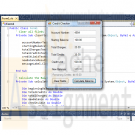
Visual Basic 2010 How to Program Deitel Credit Checker Application
$12.00Visual Basic 2010 How to Program Deitel Credit Checker Application
4.12 (Credit Checker Application) Develop an application (as shown in Fig. 4.24) that determines whether a department-store customer has exceeded the credit limit on a charge account. Each customer enters an account number (an Integer), a balance at the beginning of the month (a Double), the total of all items charged this month (a Double), the total of all credits applied to the customer's account this month (a Double), and the customer's allowed credit limit (a Double). The application should input each of these facts, calculate the new balance (= beginning balance credits + charges), display the new balance and determine whether the new balance exceeds the customer's credit limit. You can use the format "{0:C}" with String method Format, to format the result as currency (see Fig. 4.24). If the customer's credit limit is exceeded, display a message (in messageLabel at the bottom of the Form) informing the customer of this fact; otherwise, display the customer's remaining credit amount. If the user presses the Clear Fields Button, the application should clear the TextBoxes and Labels. [Note: In the next chapter, we'll introduce the data type Decimal for financial calculations.]
Learn More -
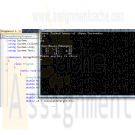
Calculate Garage Parking Charges C# Program
$10.00Calculate Garage Parking Charges C# Program
A parking garage charges a $2.00 minimum fee to park for up to three hours and an additional $0.50 per hour for each hour or part thereof over three hours. The maximum charge for any given 24-hour period is $10.00. Assume that no car parks for longer than 24 hours at a time. Write a program that will calculate and print the parking charges for each of three customers who parked their cars in this garage yesterday. You should enter the hours parked for each customer.
Your program should print the results in a neat tabular format, and should calculate and print the total of yesterday's receipts. The program should use the
function calculateCharges to determine the charge for each customer.Your outputs should appear in the following format:
Learn More
Car Hours Charge
1 1.5 2.00
2 4.0 2.50
3 24.0 10.00
TOTAL 29.5 14.50 -
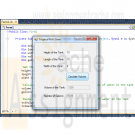
POS 408 Week 2 Tropical Fish Store
$10.00POS 408 Week 2 Tropical Fish Store
You are the owner of a tropical fish store. Write the program in VB.Net (not Web based) to accept the height, length and width of the tank that a customer might order (in inches). Include a button that when clicked, will display the volume of the tank (height x length x width) and the number of gallons on water it will hold (volume / 231). Make sure to label the results. Insert comments to document the program.
Learn More
Include appropriate labels and a title for the tool. -
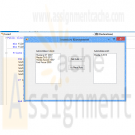
BMIS 208 Programming Assignment 7 Maintain Inventory
$15.00BMIS 208 Programming Assignment 7 Maintain Inventory
In this assignment, you are to design an inventory management program for a car dealership that specializes in one-of-a-kind automobiles. All of the automobiles currently in stock are listed in the text file, “AutosInStock.txt”. When an automobile is sold, your program should move it from the “AutosInStock” textfile into another textfile “AutosSold” textfile. If the AutosSold textfile doesn’t not already exist (and it doesn’t the first time your application is run), your program should create it. Further, when a customer fails to make payments on an automobile that they have purchased from the dealership, the automobile is repossessed and re-entered into stock. Therefore, your program should move any repossessed automobile from the AutosSold text file back into the AutosInStock text file. The contents of the two text files should be displayed in listboxes when the application starts. Clicking a “Sell Auto” button removes the car from the AutosInStock listbox AND text file into the AutosSold listbox AND text file. After each “move”, the listboxes should be refreshed. A quit button should be included to exit the application.
Design your form as depicted in the diagram below.
Helpful hints:
Learn More
1. The text files needed for this assignment should be placed in the bin\debug folder of the project. Note that you will not have a text file for AutosInStock. Your program should create it when it doesn’t already exist.
2. When the form opens, populate the Autos in stock listbox with the names of the cars listed in the AutosInStock text file and populate the Autos Sold listbox with the cars listed in the AutosSold text file.
3. Do NOT use arrays to populate the listboxes, but instead, use LINQ queries that read directly from the text files.
4. Use the StreamWriter in conjunction with IO.File.AppendText and IO.File.CreateText to append new directories and create new text files. (Note: You will need to use the WriteLine method to write the name of the new file to each text file.)
5. To display the contents of the directories file, use a LINQ query. Loop over all of the items in the query using a For each statement to populate the listbox.
6. Before displaying the contents of the AutosInStock and AutosSold files, make sure the files exist first. You will need to use the IO.File.Exists method in your checks.
7. Use good programming practices by clearing the listboxes before refreshing them when a change is made that affects their contents.
8. Remember to close the files after accessing them.
9. To remove a listing from a directory, you may find this code helpful as it selects only those records in the file that are not the one the user wants to remove. The code should then write the results of this query back to the file:
Private Sub RemoveFromFile(ByVal filename As String, ByVal item As String)
Dim query = From auto In IO.File.ReadAllLines(filename)
Where auto <> item
Select auto
IO.File.WriteAllLines(fileName, query.ToArray)
End Sub
10. Include appropriate error checking (i.e. check to make sure something has been selected in one of the listboxes before trying to move it to the other listbox.)
11. Use appropriate naming conventions for all controls and variables. Make sure the form has a title. Include appropriate internal documentation (i.e. comments in your code). -
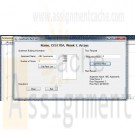
CIS170A Week 6 Lab 6 of 7 Arrays Rent List
$15.00CIS170A Week 6 Lab 6 of 7 Arrays Rent List
Learn More
Lab Overview – Scenario / Summary:
Step 1: Create a New Project
Create a Visual Basic Console Project in Visual Studio. Name the Project CIS170A_Lab06.
Write the program that will use arrays to store rent by floor and display the rent for the selected floor using the Processing Logic provided in Step 2.
Step 2: Program Description
In this project, you will create a program, using an array, which keeps a list of the rent rates for an apartment building. The rent rate for an apartment depends on which floor the apartment is located on and every apartment on the same floor has the same rent rate. The program shall read the name of the apartment building, how many floors the apartment building has, and get the rental rates for each of the floors. Once the rental rates are provided, the program shall list the rates. The program user shall be able to provide a floor number and the program will display the apartment building name, the total number of floors, the requested floor, and how much the rent is for the given floor.
The customer has several apartment buildings to choose from. The smallest apartment building has three floors and the largest apartment building has 20 floors. The program shall validate that the floor number is between the minimum and maximum floor values. Also, the minimum rental rate for any building is $1,000 per month, while the highest rent is $2,500. The program shall validate that the provided rental rates are within the minimum and maximum rates.
Design Requirements:
In Week 7, we will expand on this program and in order to easily modify it, your program will incorporate the following design features:
1. The design will be modular and the event handlers shall not contain any processing logic, but only invoke reusable modules.
2. All minimum and maximum values shall be declared as constants.
3. The user shall not be able to input the floor he or she wants to search for until after the apartment building name, the number of floors in the building, and the rent values for each of the floors in the building have been entered and validated.
4. Declare rentlist, numFloors, and requestedFloor as form level variables. All other variables should be declared locally as required.
The following shows the Program Hierarchy:
The following shows the flowchart of the program.
Step 3: Build The Form
The following is the Object, Property, Setting, Event chart for the form controls, and each input field will have a label/input field pair. Also, group the related information in the associated group box.
The form and form controls will be logically placed on the form, the controls aligned and sized, and a logical tab order will be assigned to each of the form controls.
Object Property Setting
frmRentList Text Apartment Rent List
lblHeading Text Name, Course Title, Week Number, Lab Title
grpApartmentInfo Text Apartment Building Information
lblName Text Apartment Name:
txtName Text (empty)
lblNumFloors Text Number of Floors:
txtNumberFloors Text (empty)
lstRents Items (empty)
btnRentData Text Get Rent List
grpFloorRequest Text Floor Request
lblFloor Request Text Requested Floor
txtFloorRequest Text (empty)
btnGetFloorRent Text Get Floor Rent
grpResults Text Rent Results
lblRentResults Text (empty)
grpOperations Text Operations
btnClear Text Clear
btnExit Text Exit
Step 4: Implement the Event Handlers
Use the following as the design for your event handlers, referring to the flowchart for rules on input validation and processing. The final calculation SHOULD NOT be completed until all the input fields are validated.
Control Name Event Task
txtName Validating Get apartment name
Validate apartment name
txtNumberFloors Validating Get number of floors
Validate number of floors
btnRentData Click Collect Floor Rent
Get Data
Add to lstRents
txtFloorRequests Validating Get requested floor
Validate requested floor
btnGetFloorRent Click Find Floor Data
Display Floor Data
btnClear Click Clear all textboxes and output label
btnExit Click Close program (Hint: use “Me.close”)
frmRentList Load Clear all textboxes and output label (Hint: call the ClearFields module)
Step 5: Executing the Program
To execute your code, click Start and then start debugging. Check your output to ensure that you have space(s) where appropriate. If you need to fix anything, close your execution window and modify your code as necessary and rebuild.
Step 6: Deliverables
1. Capture a screen print of your output [Do a PRINT SCREEN and paste into an MS Word document].
2. Copy your code and paste it into the same MS Word document that contains the screen print of your output.
3. Save the Word document as CIS170A_Lab06_LastName_FirstInitial
4. Zip up the Word document along with the complete set of project files into a single document.
5. Place deliverables in the Dropbox.
END OF LAB




